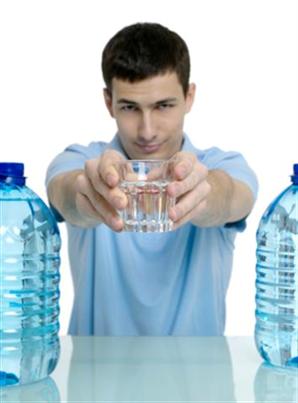Chlorine in water
You Can Avoid Drinking It
But Is That Enough?
Chlorine in water, is it in YOUR water? Chlorine is used everyday in common household products and we find it in water supplies throughout the world where it is very effective at killing germs. Most of us are vaguely aware that chlorine in water isn't good for us - that's why we drink bottled or filtered water regularly.
But are you aware that the same chlorine in water might be making you sick - even if you are NOT drinking it?
While not the most toxic substance known to man, it's pretty high on the list of Environmental Toxins. present in our home. That's mainly because of its pervasiveness. It seems that it is found everywhere: in our water, in household cleansers and in laundry bleach.
Chlorine in Water
We drink it - that's one way that we get it into our bodies - we also absorb it through the Skin. But chlorine in water also likes to combine with other toxic chemicals to form an environmental toxin called chloroform that we can then inhale.
And this absorption and inhaling goes on just about every day in most every home in the western world. Every time we wash our hands, do the dishes, brush our teeth, shower, clean house or do laundry - we are exposed to chlorine in water!

And a lifetime of the toxic build up of chlorine in water has been linked to:
• "A positive association between consumption of chlorination by-products in drinking water and bladder and rectal cancer in humans." -Medical College of Wisconsin
• "Increased risk of chronic myeloid leukemia... with exposure to... chlorination disinfection by-product..." -Canadian Cancer Registries
• "...a significant association of stillbirths with maternal residence in areas with high TTHM (chlorine byproduct)exposure." -Imperial College of London
Just what else is it doing to us that can't be 'definitively' linked to a specific disease?
OK. But how much exposure do we actually get? A shower can't expose us to that many toxins, can it?
Actually it can. Several studies have been done that took blood samples after showering with chlorine in water. Blood levels showed significant elevation of chlorine by products, such as trihalomethanes, after showering.
In fact, one study concluded,
"The results revealed that the highest risk (of cancer) comes from the inhalation exposure to chloroform during showers."
Now, as much as Americans don't like to hear this, showering and bathing as much as we do is simply A BAD HABIT!
It is absolutely not necessary for good health or social purposes to shower twice a day or even once a day (unless of course you get physically dirty or excessively sweaty on a regular basis). It may make you "feel good" or wake you up for your day, but there are other ways to do those things without exposing yourself unnecessarily to environmental toxins and wasting precious resources (see Handwashing Page for a more in-depth discussion of hygiene).
Dry Brushing the skin with a natural bristle brush used exclusively for that purpose is a great way to get energized AND exfoliate your skin at the same time.
A little yoga or meditation can really get you started out on the right track in the morning and provide other health benefits as well.
Other Ways We Absorb Chlorine
Toxic Chemicals are present in large quantities in most household cleaning products as well.
It's common for people to use plain diluted bleach as a disinfectant in their homes. As a disinfection agent it is terrific. It kills bugs that tend to be difficult to kill in other ways and really kills the pathogens that most people worry about in their homes such as Salmonella (from raw poultry) and E-coli (from raw beef and from fecal matter).
Many household cleansers contain chlorine for the same reason.
It's really cheap too.
But there is a price to pay for this cleanliness. Aside from the potential negative effects of having a 'too clean' home that doesn't provide us with enough good bacteria to keep us healthy, all that cleansing has us absorbing and inhaling significant amounts of toxic chemicals. If you still use bleach, watch your reaction the next time you open up a bottle. Most people will scrunch up their face and turn away. This is a natural reaction to environmental toxins that our bodies know will affect our health negatively.
If you don't, it means that you have probably destroyed the chemical receptors in your nose from continual exposure. Not a good thing. Your body is losing its ability to protect you from harm. Animals tend to be very sensitive to toxic chemicals and will often have very strange reactions of squinting their eyes and keeping far away from the source of chemicals. We should be so smart.
Laundry is another source of bleach use in the home. Sure, it gets your clothes white, but it not only destroys the fibers in your clothes to do so, but the hot water used when you bleach aerosolizes the chlorine in water throughout your home. Have you even come home to a load of laundry being bleached. Yep, that's toxic chemicals you are breathing in. To make it even worse, many laundry detergents now contain antibacterials like Triclosan that combine with the bleach to make chloroform, as we discussed earlier.
And studies have found significant amounts of chlorine in the air in homes after someone showered or did the dishes or laundry in hot water.
There could potentially be links to chlorine in water with other diseases as well, but researchers don't study the correlation of toxic build up of chemicals in the body and its relation to illness.
They also don't study the interaction of multiple chemicals
reacting together in the body. These types of studies are very difficult to set up and carry out.
But what IS certain is that chronic illness is rampant in developing countries and that every day we are developing a 'body burden' of toxic chemicals that were never meant to be there.
The fact that we must either store these environmental toxins (usually in our fat) or detoxify them is undeniable. And as more and more studies come out that show the health effects from these chemicals, we will have to wake up and take action if we want to preserve or regain our health and stop being the victims of our environment.
What You Can Do
There are many things that you can do to decrease your exposure.
• Take cooler showers. Hot water aerosolizes toxic chemicals more readily.
• Take shorter showers. Or at least turn the water off when you are lathering. It is another ‘bad habit’ that most people leave the water running for the entire shower.
• Take showers less frequently. Start taking a shower every other day instead of every day. If you have drier skin then every third day is fine. You can wash your face and ‘high odor’ areas of your body with a washcloth between times.
• Drink filtered water that specifically states chlorine in water has been removed.
Back to Top of Chlorine in water Page
Go to Home Page





